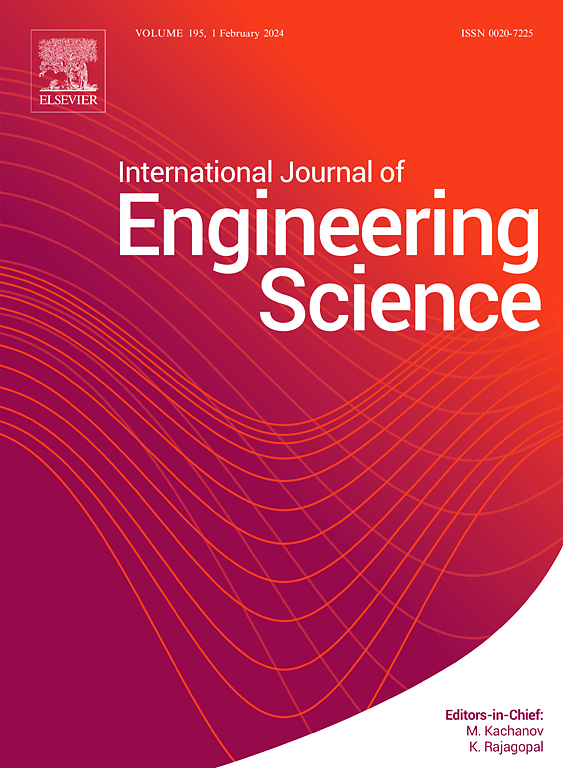Modelling visco-hyperelastic response of Silicone based elastomers for soft robotics and foldable structure applications
IF 5.7
1区 工程技术
Q1 ENGINEERING, MULTIDISCIPLINARY
International Journal of Engineering Science
Pub Date : 2025-03-22
DOI:10.1016/j.ijengsci.2025.104253
引用次数: 0
Abstract
Silicone elastomers play a critical role in the construction of soft robotics and foldable devices, owing to their exceptional versatility and mobility. This necessitates the development of innovative approaches in constitutive modeling to accurately simulate their behavior and optimize the design of such devices. Samples from five elastomers namely Smooth Sil 936, Clearflex 30, Dragon Skin 10 SLOW, Dragon Skin FX-Pro, Ecoflex 00–30, were subjected to both monotonic tensile tests and cyclic tests following the ASTM D412 standard. Smooth Sil 936 exhibited the highest stiffness and was selected for viscoelastic experimental characterization. To comprehend the time-dependent and quasi-static stress response of Smooth Sil 936, a series of tensile tests were conducted at various deformation rates, along with single-step relaxation tests. A database of material parameters for finite element analysis was established by performing hyperelastic modelling with and without Mullin's effect for all elastomers. A visco-hyperelastic model was proposed for elastomeric materials, effectively capturing their time-dependent hyperelastic stress response and accounting for Mullin's effect during cyclic loading. This model was calibrated using specific parameters for Smooth Sil 936, and the simulation results demonstrated good agreement with experimental data.
柔性机器人和可折叠结构中硅基弹性体粘弹性响应建模
硅弹性体由于其卓越的多功能性和移动性,在软机器人和可折叠设备的构建中起着至关重要的作用。这就需要在本构建模的创新方法的发展,以准确地模拟他们的行为和优化这样的设备的设计。五种弹性体的样品,即Smooth Sil 936, Clearflex 30, Dragon Skin 10 SLOW, Dragon Skin FX-Pro, Ecoflex 00-30,按照ASTM D412标准进行单调拉伸试验和循环试验。光滑的Sil 936表现出最高的刚度,并被选中进行粘弹性实验表征。为了了解光滑Sil 936的时间依赖性和准静态应力响应,在不同变形速率下进行了一系列拉伸试验,并进行了单步松弛试验。通过对所有弹性体进行有Mullin效应和无Mullin效应的超弹性建模,建立了用于有限元分析的材料参数数据库。提出了弹性体材料的粘-超弹性模型,有效地捕捉了弹性体材料在循环加载过程中的随时间变化的超弹性应力响应,并考虑了穆林效应。利用Smooth Sil 936的特定参数对模型进行了标定,仿真结果与实验数据吻合较好。
本文章由计算机程序翻译,如有差异,请以英文原文为准。
求助全文
约1分钟内获得全文
求助全文
来源期刊

International Journal of Engineering Science
工程技术-工程:综合
CiteScore
11.80
自引率
16.70%
发文量
86
审稿时长
45 days
期刊介绍:
The International Journal of Engineering Science is not limited to a specific aspect of science and engineering but is instead devoted to a wide range of subfields in the engineering sciences. While it encourages a broad spectrum of contribution in the engineering sciences, its core interest lies in issues concerning material modeling and response. Articles of interdisciplinary nature are particularly welcome.
The primary goal of the new editors is to maintain high quality of publications. There will be a commitment to expediting the time taken for the publication of the papers. The articles that are sent for reviews will have names of the authors deleted with a view towards enhancing the objectivity and fairness of the review process.
Articles that are devoted to the purely mathematical aspects without a discussion of the physical implications of the results or the consideration of specific examples are discouraged. Articles concerning material science should not be limited merely to a description and recording of observations but should contain theoretical or quantitative discussion of the results.
 求助内容:
求助内容: 应助结果提醒方式:
应助结果提醒方式:


